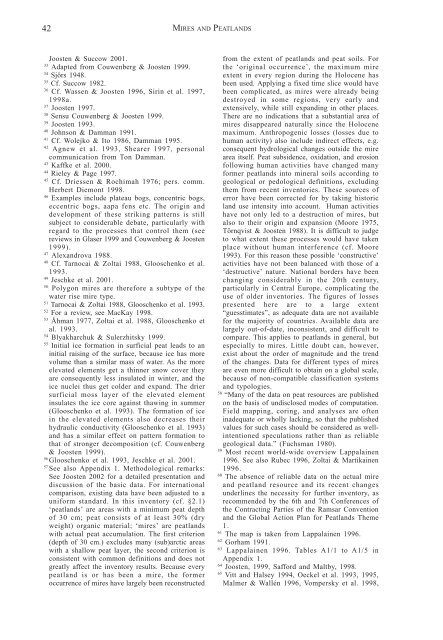wise use of mires and peatlands - Peatland Ecology Research Group
wise use of mires and peatlands - Peatland Ecology Research Group
wise use of mires and peatlands - Peatland Ecology Research Group
You also want an ePaper? Increase the reach of your titles
YUMPU automatically turns print PDFs into web optimized ePapers that Google loves.
42 MIRES AND PEATLANDSJoosten & Succow 2001.33Adapted from Couwenberg & Joosten 1999.34Sjörs 1948.35Cf. Succow 1982.36Cf. Wassen & Joosten 1996, Sirin et al. 1997,1998a.37Joosten 1997.38Sensu Couwenberg & Joosten 1999.39Joosten 1993.40Johnson & Damman 1991.41Cf. Wolejko & Ito 1986, Damman 1995.42Agnew et al. 1993, Shearer 1997, personalcommunication from Ton Damman.43Kaffke et al. 2000.44Rieley & Page 1997.45Cf. Driessen & Rochimah 1976; pers. comm.Herbert Diemont 1998.46Examples include plateau bogs, concentric bogs,eccentric bogs, aapa fens etc. The origin <strong>and</strong>development <strong>of</strong> these striking patterns is stillsubject to considerable debate, particularly withregard to the processes that control them (seereviews in Glaser 1999 <strong>and</strong> Couwenberg & Joosten1999).47Alex<strong>and</strong>rova 1988.48Cf. Tarnocai & Zoltai 1988, Glooschenko et al.1993.49Jeschke et al. 2001.50Polygon <strong>mires</strong> are therefore a subtype <strong>of</strong> thewater rise mire type.51Tarnocai & Zoltai 1988, Glooschenko et al. 1993.52For a review, see MacKay 1998.53Åhman 1977, Zoltai et al. 1988, Glooschenko etal. 1993.54Blyakharchuk & Sulerzhitsky 1999.55Initial ice formation in surficial peat leads to aninitial raising <strong>of</strong> the surface, beca<strong>use</strong> ice has morevolume than a similar mass <strong>of</strong> water. As the moreelevated elements get a thinner snow cover theyare consequently less insulated in winter, <strong>and</strong> theice nuclei thus get colder <strong>and</strong> exp<strong>and</strong>. The driersurficial moss layer <strong>of</strong> the elevated elementinsulates the ice core against thawing in summer(Glooschenko et al. 1993). The formation <strong>of</strong> icein the elevated elements also decreases theirhydraulic conductivity (Glooschenko et al. 1993)<strong>and</strong> has a similar effect on pattern formation tothat <strong>of</strong> stronger decomposition (cf. Couwenberg& Joosten 1999).56Glooschenko et al. 1993, Jeschke et al. 2001.57See also Appendix 1. Methodological remarks:See Joosten 2002 for a detailed presentation <strong>and</strong>discussion <strong>of</strong> the basic data. For internationalcomparison, existing data have been adjusted to auniform st<strong>and</strong>ard. In this inventory (cf. §2.1)‘peatl<strong>and</strong>s’ are areas with a minimum peat depth<strong>of</strong> 30 cm; peat consists <strong>of</strong> at least 30% (dryweight) organic material; ‘<strong>mires</strong>’ are peatl<strong>and</strong>swith actual peat accumulation. The first criterion(depth <strong>of</strong> 30 cm.) excludes many (sub)arctic areaswith a shallow peat layer, the second criterion isconsistent with common definitions <strong>and</strong> does notgreatly affect the inventory results. Beca<strong>use</strong> everypeatl<strong>and</strong> is or has been a mire, the formeroccurrence <strong>of</strong> <strong>mires</strong> have largely been reconstructedfrom the extent <strong>of</strong> peatl<strong>and</strong>s <strong>and</strong> peat soils. Forthe ‘original occurrence’, the maximum mireextent in every region during the Holocene hasbeen <strong>use</strong>d. Applying a fixed time slice would havebeen complicated, as <strong>mires</strong> were already beingdestroyed in some regions, very early <strong>and</strong>extensively, while still exp<strong>and</strong>ing in other places.There are no indications that a substantial area <strong>of</strong><strong>mires</strong> disappeared naturally since the Holocenemaximum. Anthropogenic losses (losses due tohuman activity) also include indirect effects, e.g.consequent hydrological changes outside the mirearea itself. Peat subsidence, oxidation, <strong>and</strong> erosionfollowing human activities have changed manyformer peatl<strong>and</strong>s into mineral soils according togeological or pedological definitions, excludingthem from recent inventories. These sources <strong>of</strong>error have been corrected for by taking historicl<strong>and</strong> <strong>use</strong> intensity into account. Human activitieshave not only led to a destruction <strong>of</strong> <strong>mires</strong>, butalso to their origin <strong>and</strong> expansion (Moore 1975,Törnqvist & Joosten 1988). It is difficult to judgeto what extent these processes would have takenplace without human interference (cf. Moore1993). For this reason these possible ‘constructive’activities have not been balanced with those <strong>of</strong> a‘destructive’ nature. National borders have beenchanging considerably in the 20th century,particularly in Central Europe, complicating the<strong>use</strong> <strong>of</strong> older inventories. The figures <strong>of</strong> lossespresented here are to a large extent“guesstimates”, as adequate data are not availablefor the majority <strong>of</strong> countries. Available data arelargely out-<strong>of</strong>-date, inconsistent, <strong>and</strong> difficult tocompare. This applies to peatl<strong>and</strong>s in general, butespecially to <strong>mires</strong>. Little doubt can, however,exist about the order <strong>of</strong> magnitude <strong>and</strong> the trend<strong>of</strong> the changes. Data for different types <strong>of</strong> <strong>mires</strong>are even more difficult to obtain on a global scale,beca<strong>use</strong> <strong>of</strong> non-compatible classification systems<strong>and</strong> typologies.58“Many <strong>of</strong> the data on peat resources are publishedon the basis <strong>of</strong> undisclosed modes <strong>of</strong> computation.Field mapping, coring, <strong>and</strong> analyses are <strong>of</strong>teninadequate or wholly lacking, so that the publishedvalues for such cases should be considered as wellintentionedspeculations rather than as reliablegeological data.” (Fuchsman 1980).59Most recent world-wide overview Lappalainen1996. See also Rubec 1996, Zoltai & Martikainen1996.60The absence <strong>of</strong> reliable data on the actual mire<strong>and</strong> peatl<strong>and</strong> resource <strong>and</strong> its recent changesunderlines the necessity for further inventory, asrecommended by the 6th <strong>and</strong> 7th Conferences <strong>of</strong>the Contracting Parties <strong>of</strong> the Ramsar Convention<strong>and</strong> the Global Action Plan for Peatl<strong>and</strong>s Theme1.61The map is taken from Lappalainen 1996.62Gorham 1991.63Lappalainen 1996. Tables A1/1 to A1/5 inAppendix 1.64Joosten, 1999, Safford <strong>and</strong> Maltby, 1998.65Vitt <strong>and</strong> Halsey 1994, Oeckel et al. 1993, 1995,Malmer & Wallén 1996, Vompersky et al. 1998,
















